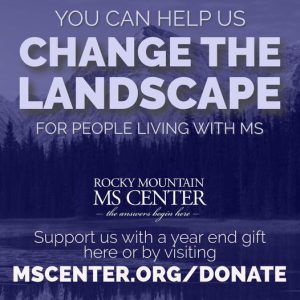Earlier this fall, PCORI (the Patient Centered Outcomes Research Institute) released a request for funding applications for comparative effectiveness studies of Multiple sclerosis (MS) disease modifying therapies (DMTs). This includes interferons, Copaxone®, Tecfidera®, Gilenya®, and Tysabri®, as well as other MS medications. Our partners at the Rocky Mountain MS Center at University of Colorado are seeking funding for a study to research the comparative effectiveness of the second generation DMTs approved for first-line use (SecGen DMTs) in relapsing forms of MS, which includes Gilenya®, Tecfidera®, and a new drug, Ocrevus®. We are pleased to let you know that our group has recently been invited to submit a full application to PCORI.
Why is this study important?
Right now, a key dilemma for relapsing MS patients, family members, insurers, and clinicians is determining the appropriate role of the three key SecGen DMTs as both first-line DMTs and as second-line DMTs when switching from first generation DMTs (FirstGen DMTs), such as interferons or Copaxone®/Glatopa®. This study would examine the comparative effectiveness, safety, and tolerability of these three key SecGen DMTs as first-line agents and as second-line agents when switching to them from the FirstGen DMTs (such as Betaseron®, Avonex®, Rebif®, Extavia®, Plegridy®, Copaxone®, and Glatopa®). The three SecGen DMTs that will be the focus of this study include: Gilenya® (fingolimod) and Tecfidera® (dimethyl fumerate), both of which are oral pills taken either once or twice a day, and Ocrevus® (ocrelizumab), a new drug to be approved soon, which is a twice a year IV infusion.
All three of these SecGen DMTs are more effective than interferons or Copaxone®/Glatopa®, and all three can be used with a high level of safety in carefully selected and monitored relapsing remitting MS (RRMS) patients. Additionally, all three of these agents have been associated with significant improvement in neurological function and quality of life in some RRMS patients. The aim of our proposed study is to identify which of these three selected second generation DMTs has the lowest treatment failure rate and the best chance of allowing patients to be free of MS disease activity and to have actually improved in function after two years of treatment.
“We have very good therapies to prevent further disability in relapsing MS and actually allow some MS patients to recover from MS symptoms,” explains Dr. Timothy Vollmer, Medical Director of RMMSC and Co-Director of RMMSC at the University of Colorado, “But we need to know how to select the best therapy for the individual MS patient by providing high quality data that patients, physicians, and health care payers can use to make these decisions.”
Your Input is Needed – Please complete brief patient survey OR caregiver survey today.
Now, we need your help to design our study and gather important data to move forward with the application process. The point of view of MS patients and their family members is of key importance to us as we design this study. The purpose of the study is to provide MS families and MS physicians with information allowing them to select the best DMT for each individual. If you have MS or have a loved one with MS, will you please take a few minutes to complete a brief survey today?
[su_list icon=”icon: circle” icon_color=”#0c1975″]- If you are an MS patient, please CLICK HERE to complete this brief survey:https://www.surveymonkey.com/r/TB79WRG
- If you are a caregiver or family member of an MS patient, please CLICK HERE to complete this brief survey: https://www.surveymonkey.com/r/MQL6TLC[/su_list]
You are helping us be more effective in bringing the best treatment to the forefront for each MS family. We thank you very much for your invaluable input!


